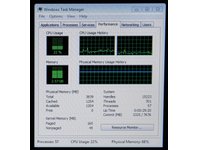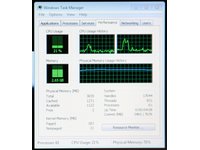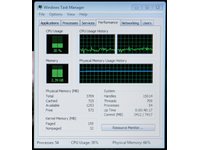ASRock's E350M1: AMD's Brazos Platform Hits The Desktop First
We had the opportunity to preview the Zacate APU late last year at AMD’s headquarters in Austin, Texas. Now we have the first retail motherboard based on the Brazos platform in ASRock’s E350M1. Today we’re asking: what can the Fusion initiative really do?
The First Inklings Of Fusion: On-Die Video Decoding Via UVD3
Equipped with a modest 80 stream processors, graphics performance will never be Zacate’s flagship feature. However, the addition of AMD’s UVD 3 fixed-function decoding block makes it possible to watch high-bit rate content without taxing the lightweight Bobcat cores.
As mentioned previously, the UVD 3 we have here isn’t exactly like what you’d find on a Radeon HD 6000-series discrete board, though. On the downside, Multiview Video Coding is not accelerated, meaning you don’t get Blu-ray 3D support. That won’t be a deal-breaker for most, since Blu-ray 3D has been very slow to catch on in light of the expensive, battery-powered, heavy glasses required for each viewer. But it might become more of a detractor if the technology gains momentum in 2011.
However, the Zacate APU also introduces MPEG-2 hardware decode at the VLD (variable-length decoding) level. MPEG-2 is a fairly easy codec to decode, so nobody really gave it much thought that AMD wasn’t accelerating the entire pipeline (iDCT- and motion comp-only). And from a performance standpoint, the Brazos platform wouldn’t have had any problems. But by building in a more complete MPEG-2 decode solution, more of the workload is handled by efficient fixed-function logic, keeping the Bobcat cores as idle as possible, and extending battery life. Naturally, this is more of a consideration for mobile machines that will center on Brazos.
Of course, we wanted to double-check that AMD’s fixed-function logic was doing its share of the heavy-lifting, so we fired up Quantum of Solace (AVC) and The Book of Eli (VC-1) using a recently-optimized copy of CyberLink’s PowerDVD 10:






Though the Athlon II and Celeron see the lowest utilization numbers, remember that the Athlon II-based machine centers on AMD’s 880G chipset, which includes UVD 2 and is driven by a 2.8 GHz desktop processor, while the Celeron benefits from Nvidia’s Ion, armed with third-generation PureVideo.
The simple fact that AMD’s E-350 hovers around 20% utilization in H.264-based video and 30% utilization decoding VC-1 is pretty impressive. Also, these numbers include audio decoding, which happens on the CPU. If you were to bitstream Dolby TrueHD or DTS-HD Master Audio over HDMI, the two Bobcat cores would have even less work to do.
I spend some time talking about my findings with Louis Chen, CyberLink’s director of business development, who shared the performance numbers his technical team had recorded. Although we don’t have access to the single-core version of Zacate or either Ontario SKU, CyberLink says even the C-50 (Ontario, 1 GHz, single-core) should be capable of Blu-ray playback using any of the three accelerated codecs. You’ll see utilization in excess of 70% in H.264 titles, but the requisite performance is there.
Get Tom's Hardware's best news and in-depth reviews, straight to your inbox.
Current page: The First Inklings Of Fusion: On-Die Video Decoding Via UVD3
Prev Page ASRock E350M1: Enter Brazos Next Page More Inklings: Video Transcoding-
iam2thecrowe now they need some devs to take advantage of that apu to see its full potential as a processor.Reply -
Reynod This is an awesome processor ...Reply
Chris ... did you manage to overclock it at all?
Give it your best shot ... call crashman in with the liquid nitrogen if you need to mate !!
Really impressive stats for such a small piece of silicon. -
dogman_1234 So the Brazo is great for media and hard processing I assume. If someone came to me and asked for a good platrom to watch Blu-Ray...I would say get the Brazo APU for them, right?Reply -
sparky2010 Nice, things are starting to look good for AMD, and i hope it stays that way as they start unveiling their mainstream and highend processors, because i'm really fed up with intel dictating crazy prices.....Reply -
cangelini reynodThis is an awesome processor ... Chris ... did you manage to overclock it at all?Give it your best shot ... call crashman in with the liquid nitrogen if you need to mate !!Really impressive stats for such a small piece of silicon.Reply
Didn't get a chance to mess with overclocking. If this is something you guys want to see, I might try to push it a little harder over the weekend. -
joytech22 cangeliniDidn't get a chance to mess with overclocking. If this is something you guys want to see, I might try to push it a little harder over the weekend.Reply
Yeah that would be much appreciated, these little chips are so much faster than Atom, let's see if you can get them to perform similarly to a Dual-Core CPU at 1.8GHz -
cangelini Alright, I'll see what I can do. A shiny new video card landed this afternoon, so that's going to monopolize the bench for much of the weekend ;)Reply -
dEAne Yes integration is the key to higher performance, lower power consumption and lower price (affordability this is what people really wanted).Reply -
haplo602 can you also run gaming benchmarks with a 5670 or similar plugged into the PCIe slot ? Just to have a look how the limited memory interface will bottleneck ...Reply
also what happens with the intgrated graphics core when you plug in a discreet GPU ? you gave so much detail about this in the sandy bridge review but totaly skip it for Fusion ...
the board got me interested. I am trying to buy a small "workstation terminal" ... something to code OpenGL/OpenCL on a budget. Seems this is what I am looking for.
